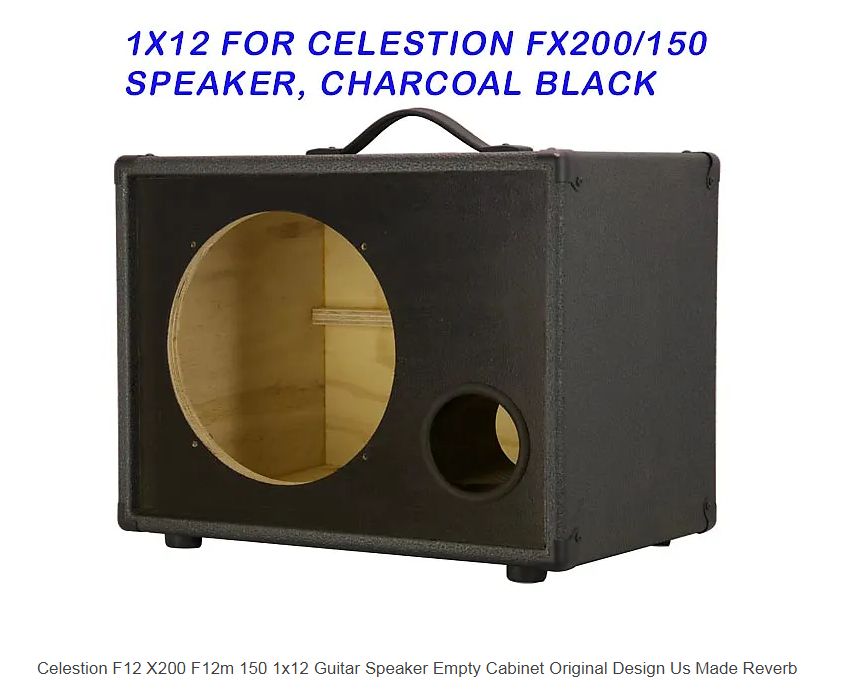Celestion on Building Guitar Cabinets
September 16, 2011
A 1×12 comboAs guitar speakers are different, so their cabinets are different. The box design is acoustically less critical than that for hi-fi or PA systems, but proper construction is essential.
Primarily, the cabinet is a convenient way of housing the speaker, so it should be solidly built to ensure no joint vibration (unpleasant buzzing), and be strong enough to withstand hard use. After all guitar speakers are quite heavy and amplifiers that sit on top of guitar cabs are even heavier.
Guitar cabs aren’t built to provide bass extension like a PA box might, but they do perform an “acoustic” function. If the driver were used without any cabinet at all, the sound coming from the rear of the unit would cancel out some of the sound coming frm the front, thereby reducing the amount of bass heard. Enclosing the the speaker inside a cabinet reduces this effect resulting in a truer bass performance that is neither enhanced nor attenuated.
For illustrative purposes, a basic design for a 2×10 or 1×12 open back cabinet is shown here. To build a cabinet like this we would recommended the use of 15mm plywood with number 10 screws positioned no more than 150mm (6″) apart.
Panel joints can be simple butt-joints, screwed and glued, with reinforcing battens (you can use more sophisticated joints if your woodworking skills are up to it!) Whatever joint type you use, it is important that the whole thing is both airtight and secure.
The drivers can be mounted to the front or the back of the baffle. Front mounting makes a very simple job of dropping the speaker in or out of the cabinet. In either case it’s preferable to use mounting bolts and T-nuts to fix the driver to the baffle.
There is a wide range of speaker cabinet accessories available from specialist suppliers. Fitted carefully so as not to weaken the box or create air leaks; wheels, handles, grilles and corners all add to convenience and durability.
http://celestion.com/speakerworld/guitartech/3/7/Build_Your_Own_Guitar_Cab/
Guitar speaker cabinets, often simply called “cabs,” are an essential component of electric guitar gear, especially when using separate heads and cabinets, known as a “stack” configuration. The cabinet houses one or more loudspeakers and plays a crucial role in shaping the overall sound and tonal character of the guitar signal. Understanding the key features and variations of guitar speaker cabinets can help you choose the right one for your sound and performance needs.

Types of Cabinets
– Closed-Back Cabinets: Offer a tighter, more focused sound with enhanced low-frequency response. They project sound forward, making them suitable for louder, more defined rock or metal tones.
– Open-Back Cabinets: Provide a wider, airier sound with more ambient spread. They’re favored for their ability to blend with a room’s acoustics, offering a natural sound suitable for jazz, blues, and classic rock.
Size and Configuration
– 1×12″ (One 12-inch Speaker): Popular for their balance between size and output, offering a good compromise between portability and performance. Suitable for practice, studio, and small venues.
– 2×12″ (Two 12-inch Speakers): A favorite for gigging musicians seeking a fuller sound without the bulk of larger cabinets. They can deliver a wide stereo image and substantial volume.
– 4×12″ (Four 12-inch Speakers): The classic “full stack” look and sound, providing powerful output and the iconic punch and presence associated with rock and metal genres. Despite their size, they’re preferred for large venues and stages.
Speaker Characteristics
– Speaker Type: The type of speaker(s) used in a cabinet significantly affects the tonal characteristics. Options range from vintage-style speakers that offer warm, smooth tones to modern speakers designed for higher power handling and more aggressive sounds.
– Impedance: Matching the cabinet’s impedance to the amplifier’s output is crucial for optimal performance and to avoid damage. Common impedances are 4, 8, and 16 ohms.
Materials and Construction
– Wood Type: The cabinet’s construction material can influence its sound. Plywood is common for its balance of durability and acoustic properties, while solid wood cabinets (like pine) offer distinct tonal nuances.
– Build Quality: Solid construction can enhance the cabinet’s resonance and overall sound quality. Details such as the baffle (the board to which the speaker is mounted) and the back panel design (closed or open) also contribute to the cabinet’s sonic characteristics.
Usage and Considerations
– Portability vs. Output: Smaller cabinets are easier to transport and suitable for smaller venues or home use, while larger cabinets offer more volume and presence for bigger venues or specific tonal characteristics.
– Tonal Preferences: The choice between open-back and closed-back, the number and type of speakers, and the cabinet’s construction materials should be guided by the desired tone and the musical context in which the cabinet will be used.
Conclusion
Guitar speaker cabinets are more than just a box for speakers; they’re a critical component of a guitarist’s sound. The right cabinet can complement an amplifier’s characteristics, enhance certain frequencies, and contribute to the overall musical expression. Whether you’re playing at home, recording in a studio, or performing live, understanding the nuances of guitar speaker cabinets can help you achieve your ideal sound.